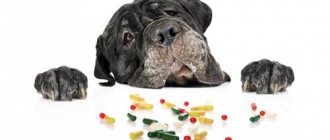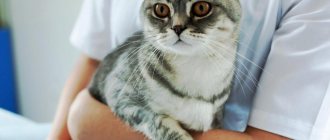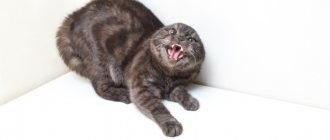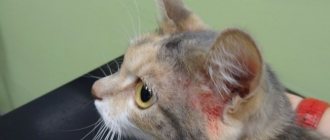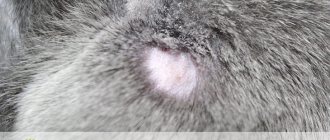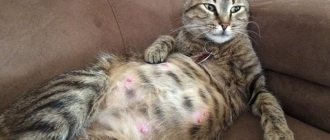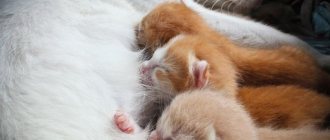Adult cats and cats are real predators. Animals that have free range are happy to catch birds and mice. And especially seasoned cats do an excellent job even with rats. For humans, the extermination of rodents near residential buildings is very good, but for cats there may be danger lurking here. Cats can become poisoned by drugs used to kill rodents. If a cat eats a poisoned mouse, it begins to become intoxicated, which can be fatal.
How can a cat get poisoned?
Almost all poisons used to kill rodents are zoocoumarins.
These drugs reduce blood clotting and provoke various types of bleeding. Typically, the poison must be taken regularly for it to be effective. If a cat eats a poisoned mouse or rat once, then nothing threatens its health, but if eating rodents occurs repeatedly, then poisoning is possible. In addition, your pet can become poisoned if it periodically eats rat and mouse bait. There is a group of drugs that also belong to the latest generation of coumarins. These poisons are more toxic:
- Zinc phosphide.
- Bromethalin.
- Sodium fluoroacetate.
Such drugs are very poisonous for animals; poisoning can result from consumption of bait or a rodent infected with poison. Food baits that are used to fight mice will be of little interest to a cat, since they are made on the basis of a grain mixture. But bait for rats is often made based on meat or fish products.
What to do?
Treatment in a medical facility
After these manipulations, the pet should be taken to the clinic. However, it is better to do this immediately when signs of rat poisoning appear, since an experienced specialist knows better what treatment is required. Before starting therapy, the veterinarian asks the animal owners about what could have poisoned the cat. The pet is then sent for urine and blood tests. After receiving the test results, the cat is prescribed an antidote. Vitamin K1 is mainly used for these purposes, which normalizes blood clotting and strengthens vascular walls. In the absence of this substance, vitamin K3 can be used.
The successful outcome of treatment directly depends on whether a lethal dose of rat poison was consumed, how many rats the cat ate, and the amount of time that passed from the moment of poisoning to the start of therapy. In addition, the age of the pet and the presence of additional diseases affect it.
Care and nutrition during the recovery period
During the recovery period, it is recommended to give the animal a lot of water, but milk is prohibited.
In the first 24 hours after poisoning, the pet is prohibited from giving food. Veterinarians only allow the cat to be given water. The next day, it is permissible to include in the diet low-fat fish and meat, glutinous cereals, boiled vegetables and low-fat fermented milk products. During the first 2-3 months of the recovery period, feeding should be carried out at least 4 times a day. The products will need to be cut into small cubes or chopped with a blender. At this time, the pet is not allowed to give milk.
Since poisoning has a detrimental effect on internal organs, including the liver, heavy food should not be on the cat’s menu. You can resort to the help of purchased complementary foods, which are created specifically to support the filtration organ after intoxication of the body. If a pet refuses to eat food, doctors do not recommend giving it forcibly. When your pet has not eaten for more than 3 days, he should be taken to a veterinarian who will prescribe intravenous nutrients.
Signs of a cat being poisoned by rat poison
If the cat is affected by rat poison or other poisons from the group of zoocoumarins, then the symptoms will be as follows:
- various bleedings - nasal, stomach, uterine. Hemorrhages appear in the oral cavity. These symptoms can develop within ten days after the toxic drug enters the body;
- vomiting – this symptom does not necessarily appear. Happens immediately after eating a poisoned rodent;
- internal bleeding - with such damage, the cat can die within a few days, without any obvious signs of poisoning.
You can recognize that poisons of this type are used in the area by looking at already dead rodents. They may notice blood coming from the rectum or mouth.
If a cat eats a mouse poisoned with rat poisons of other groups, the symptoms will be as follows:
- increased excitability, nervousness, atypical dynamism;
- complete loss of coordination - the animal’s gait is unstable, its paws get tangled, and the cat falls over on its side. There may be involuntary head shaking;
- neurological manifestations - convulsions, twitching of muscles and paws;
- body temperature rises significantly;
- the animal becomes lethargic and drowsy.
When the first signs of poisoning appear, your pet must be taken to a veterinary clinic!
Symptoms of poisoning
The principles of action of the poison directly determine what symptoms your pet will have if poisoned.
So, if an animal ate a poison from the category of zoocoumarins, then it:
- There will be bleeding from the nose. There may also be blood discharge in the stool or urine.
- Vomit. Maybe normal or mixed with blood.
- Cramps.
- Tachycardia.
- Refusal to eat.
- Heat.
- Shortness of breath.
The most insidious thing about rat poisoning is the late onset of symptoms. So, depending on the effect of the drug, symptoms may appear after 4-6 days or even 2-4 weeks. A poisoned cat may feel well at first and not show any signs of poisoning. Therefore, it is so important to constantly monitor the cat and know how to properly provide him with first aid if necessary.
© shutterstock
First aid for a cat in case of poisoning
What should you do first if your cat has eaten a rodent and is worried? The sequence of actions is given below:
- Induce vomiting - this procedure makes sense only if the cat has eaten suspicious food in full view of the owners. Otherwise, the poison has long been absorbed into the bloodstream, and vomiting will cause the condition to worsen due to dehydration. To provoke vomiting in a cat, you need to give a 3% solution of hydrogen peroxide and water in equal parts. A teaspoon of this solution is per 2 kg of cat weight. You can use a concentrated solution of table salt or sprinkle a pinch of soda on your cat's tongue. The prepared solutions are infused into the cat by force, using a syringe without a needle or syringe.
- To neutralize toxins in the stomach, the cat is given any sorbent that is available in the home medicine cabinet. The drug is dissolved in half a glass of warm water and poured into the pet’s mouth.
- Next, the cat is fed any enveloping foods that will reduce the absorption of poison into the mucous membranes. It can be raw eggs, milk jelly, or a decoction of flaxseeds.
Sorbents and products that envelop the mucous membrane are given to the animal only after vomiting has completely stopped.
- Three hours after the last dose of the coating agent, the cat is given a laxative. A 2% solution of magnesium or sodium sulfate, castor oil or petroleum jelly are suitable for this.
- Rinse the intestines with an enema. About 30 ml of saline solution or clean water is injected into the cat's rectum.
The enema liquid should be taken slightly warm. Hotter water promotes stronger absorption of toxins into the blood.
If the cat's symptoms indicate the action of anticoagulants, drugs that interfere with blood clotting, then vitamin K is injected into the muscle in a dosage of 1-2 ml. A pet's recovery is usually long and can range from three weeks to three months.
A fairly common poison for exterminating rodents is zinc phosphide. It threatens the life of a cat only when bait containing rodent poison has been eaten. When a cat eats a mouse or rat that is poisoned with this poison, there is no danger to health. When directly eating the bait, the cat’s first signs appear within a short time and look like this:
- uncontrollable vomiting, sometimes streaked with blood;
- severe pain in the gastrointestinal tract;
- a characteristic smell of rotten fish appears from the oral cavity;
- respiratory function becomes difficult;
- convulsions appear.
If the cat is not quickly provided with emergency assistance, then death occurs within a short period of time.
If an animal is intoxicated with zinc phosphide, first aid consists of washing the stomach with a 0.5% solution of copper sulfate and a 2% solution of baking soda. Medicines containing aluminum and magnesium, such as Maalox, can be given.
Detoxification as part of rehabilitation at the Healthy Stavropol Center
Poisons and toxins are deposited in body tissues regardless of the use of the methods listed above for their removal. And you can get rid of these deposits only with the help of a special step in the rehabilitation program provided in our center.
If a person has taken alcohol or drugs, this step helps to get rid of the hidden effects of these poisons: fatigue, depression, irritability, etc., caused by toxins entering the bloodstream. This is a non-medical detox; no drugs or medical techniques are used. Call us now to learn more about the program!
The rehabilitation period for a cat after poisoning
For any degree of poisoning, the cat needs to be examined by a veterinarian and prescribed adequate treatment. Even with the pet’s apparent health, the consequences can continue to manifest themselves for a long time. In addition to medications, the cat needs proper care and diet.
Within 24 hours after the first symptoms of poisoning appear, the cat is given only water and sorbents. From the second day you can start feeding the animal in small portions several times a day. The following products are used in cat food:
- boiled meat - horse meat, veal, lean beef, chicken breast;
- fish of different varieties, but not too fatty;
- boiled liver;
- vegetables - boiled carrots, beets, cauliflower;
- viscous porridges - oatmeal, buckwheat, rice.
A few days after poisoning, you can start giving small amounts of raw foods - meat, liver, fish, eggs. Liver is given raw only when you are confident in the high quality of the product and there are no signs of liver infection by parasites. Otherwise, it is better to boil it a little. Meat and fish are ground into minced meat for better digestion by a weakened stomach. You can make something like a fish and meat pate, which will be rich in minerals and vitamins. It is better to boil the egg white, it is difficult for the stomach to process, but the yolk can be added to the porridge raw.
Dairy products are gradually being reintroduced into the cat's diet. This can be low-fat milk, cottage cheese and low-fat cheese. You can give bifidokefir, which stimulates the intestinal mucosa well and helps avoid constipation.
All food for a cat during the rehabilitation period should be light, fresh and easily digestible.
Basic information
The most common poisons today are those whose operating principle is based on a disorder of blood clotting, causing a mouse that eats a poisoned bait to die from internal bleeding. The most commonly used bases are: Brodifacoum, Difacion, Warfarin and Bromadiolone. These are very effective anticoagulants. Please note: in most cases, rat poisons containing these substances are green in color. This is necessary for pet owners, since cats themselves do not see shades of green.
When this poison enters a cat's body, it destroys vitamin K and blocks blood clotting mechanisms. It should be noted that manufacturers of deratization products try to select the dose of poison so that a cat or dog that accidentally eats it does not immediately bleed to death, so that the owner has enough time to call a veterinarian and administer an antidote. However, if your pet gets hold of the package of poison, this rule will not work.
Important! If your cat has eaten mouse poison, do not let him drink it under any circumstances! If the dose was large, it will immediately develop internal bleeding, from which the animal will die.
By the way, how are cats poisoned by poisons intended to kill rats? Judging by research by veterinarians and pest control companies, more than 90% of cases occur when cats eat poisoned rodents. As you might guess, the poison does not have time to be eliminated from the body of a mouse or rat, which is why the cat that eats it also receives a loading dose of poison. Much less often, animals eat the rodent killer directly, or pick up poisoned bait accidentally or intentionally left on the street.
What not to give to a cat after poisoning
After poisoning, the cat is strictly prohibited from giving the following products:
- dry food of any class. Regardless of whether it is a budget food or a premium one, it causes severe irritation to the stomach, which has not had time to recover after the poison entered the body;
- canned cat food - this food is not healthy, it does not contain the necessary enzymes that improve digestion. Canned food should only be offered to a cat in exceptional cases;
- offal – it is worth removing tripe, udder and kidneys from the cat’s diet for a while. Boiled beef heart can be given in limited quantities;
- legumes in any form cause bloating;
- confectionery products – a high carbohydrate content is not desirable for an organism that has just experienced severe intoxication;
- bread and pasta are difficult to digest due to the weakened gastric mucosa. May cause stagnation in the digestive system.
Your cat may have poor appetite for a long time after poisoning. Under no circumstances should you force feed her. Sometimes you have to keep the animal on IVs for several days.
Intoxication and methods of combating it
Most often, people resort to detoxification due to addiction. Alcohol and drugs are poisons that poison the body. And it is worth knowing those techniques that, instead of the expected benefit, will cause harm. Here is what the chief narcologist of the Ministry of Health of the Russian Federation, Evgeniy Brun, says about this: “For example, they offer quick opiate detoxifications on the market. The person is put under anesthesia for 72 hours. Through a dropper, the patient is administered a drug - an antagonist of opiate receptors. In theory, abstinence should subside within three days. But the trick is that all this time the body also receives a narcotic load of barbiturates, which, in turn, can cause an increase in organic pathology of the brain. And one more thing: after such procedures, the craving for drugs can be so great that people immediately run away from the clinic to continue injecting drugs.
The same applies to the methods of plasmapheresis and hemodialysis, in common parlance - blood purification. Pathological attraction to drugs or alcohol increases sharply after them.”
Consequences of cat poisoning by mouse
Any poison causes severe intoxication of the body and disables all important organs and systems. A particularly toxic substance for animals is rat poison, which is used to control rodents. There may be no consequences of poisoning, but they may be very severe:
- Acute liver damage, which leads to organ enlargement and chronic jaundice.
- Neurological diseases - paralysis of limbs, loss of coordination.
- Changes in the organs of vision - with severe poisoning, a cat may develop optic nerve atrophy and blindness.
- Hearing impairment.
- Disorders of the urinary system - urinary incontinence and chronic inflammation of the bladder.
- Persistent allergic reactions, which are accompanied by hair loss and itching.
- Reproductive dysfunction.
- Comatose state and death.
Diagnosis and treatment
The diagnosis of rodenticide poisoning is made based on the owner's story, clinical symptoms of intoxication, blood tests for the presence of anticoagulants, urine tests and the body's response to treatment.
After emergency measures are taken and the animal is stabilized, he is prescribed maintenance therapy lasting several weeks, during which he will need to take Vitamin K1 tablets.
Discontinuation of treatment is based on a trial of drug withdrawal and control blood clotting tests.
The antidote for other types of rat poisons, as well as for arsenic, mercury and other thiol poisons, is Unithiol (human preparation). It is used, for example, if the poison contains arsenic in addition to zoocoumarin.
The prognosis for recovery depends on the type of poison and its amount, the time of diagnosis and the start of proper treatment. Under favorable circumstances it is approximately 83%.
Unfortunately, late onset of symptoms and untimely treatment at the clinic, and the lack of an antidote often lead to death.
Since vitamin K is metabolized in the liver, the prognosis for animals with disease in this organ is much worse.
How to protect your cat from poisoning
Cats are animals that walk on their own. Unlike dogs, it is difficult for them to put on a collar and dictate the path of a walk. These animals love freedom and independence. To avoid severe poisoning in cats, you need to follow a few rules. A cat should always be fed before walking; with a full stomach, it will not look for food on the street. You should not scatter poisoned bait for rodents in the house and surrounding area; it is better to use the services of a sanitation station.
Love your pets and be extremely attentive to them. If your cat shows signs of illness, do not turn a blind eye. It depends on the actions of the owner how quickly the cat recovers from poisoning and whether it will have any consequences. The person’s task is to deliver the cat to the hospital as quickly as possible.
2.How can harmful microbes get into food?
- During meat processing. There are bacteria in the intestines of animals that humans use as food. This is normal, but sometimes bacteria also get on those parts of animals (meat) that we eat.
- Because of the water that is used to water or wash fruits and vegetables. If there are microbes in this water (most often these are microbes from animal manure and household wastewater), they can transfer to the food.
- While cooking. If items that have germs on them come into contact with food, the germs can be transferred to them. For example, if you use the same cutting board to cut vegetables and raw meat, germs can transfer to the vegetables. The same thing happens if you don’t wash your hands well after cutting meat.
Visit our Therapy page
Precautionary measures
It just so happens that cats are predators, and eating rodents is a natural behavior for them. Accordingly, they will always be at risk; it is very difficult to prevent cases of poisoning. Perhaps the most protected are cats living in city apartments, but even in this case it is possible that poisoned rodents may enter the house (during mass deratization).
So here everything depends on the vigilance and attentiveness of the animal’s owners. If you hear that your area will be treated for rats and mice (and by law, the sanitary and epidemiological station is required to warn about this), do not let your cat go outside. If you notice something strange in your pet's behavior, immediately take him to the veterinarian: it is possible that he has already eaten a poisoned rodent. Always have a supply of activated carbon at home, with which you can provide first aid to your cat in case of poisoning.
Important! Be sure to try to find packaging or samples of the poison. This will help in prescribing adequate therapy.
Therapy
The first aid immediately after a cat swallows poison is the administration of drugs that induce vomiting, or the administration of large quantities of activated charcoal, followed by gastric lavage. Alas, in almost all cases when internal bleeding has already developed, it is necessary to transfuse the animal with blood or blood-substituting compounds, plasma. Considering that most domestic veterinary clinics do not have such capabilities, it is advisable not to let things get to this point.
A natural antidote to such poisons is vitamin K. Immediately after the start of treatment, it is administered by injection, when the animal’s condition stabilizes, they switch to prescribing tablets. At first, the vitamin is administered in loading doses, since under the influence of the poison most of it will still be destroyed in the body. Please note that it is best to use Vikasol for treatment , since multivitamin preparations contain too small amounts of it.
It should be remembered that there are different options for anticoagulant compounds, each of which remains in the animal’s body for a different time. This can make it very difficult to determine when it is time to end treatment. As a rule, they do this: stop prescribing the drug, and then (two days later) take a blood test. Platelet levels are checked. If the poison remains in the animal’s body, their level will be noticeably reduced, and therefore therapy is continued. If all indicators are normal, the medication can be stopped completely.
